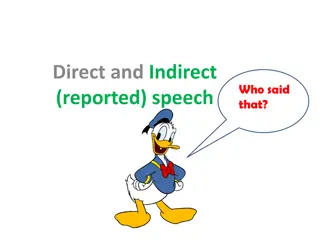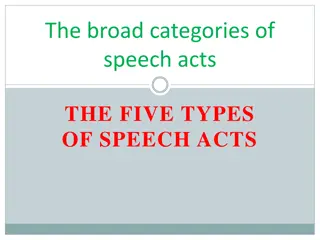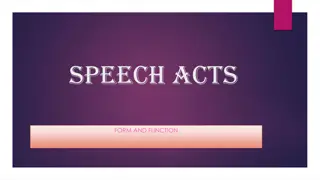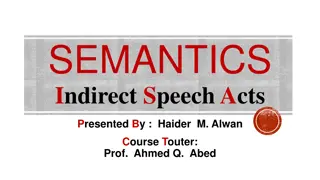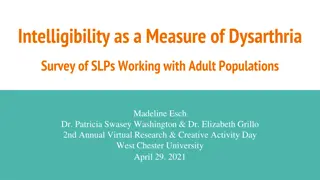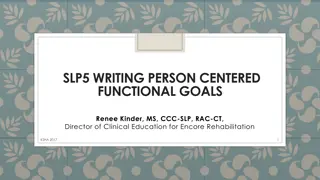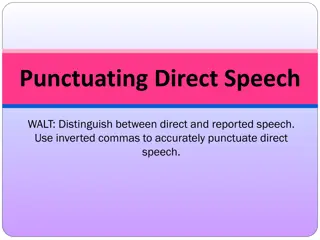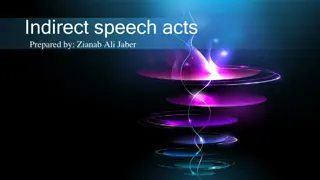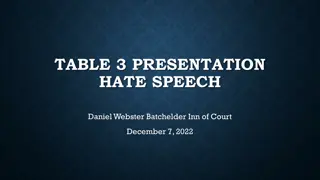Speech Acts and Events in Communication
Speech acts and events play a crucial role in communication by impacting how utterances are interpreted. Speech acts such as apologies, compliments, complaints, and invitations are performed through utterances, with the locutionary act producing linguistic expression, illocutionary act conveying communicative force, and perlocutionary act generating effects. Different illocutionary forces can be derived from the same locutionary act, showcasing the complexity of language usage and interpretation.
Download Presentation

Please find below an Image/Link to download the presentation.
The content on the website is provided AS IS for your information and personal use only. It may not be sold, licensed, or shared on other websites without obtaining consent from the author.If you encounter any issues during the download, it is possible that the publisher has removed the file from their server.
You are allowed to download the files provided on this website for personal or commercial use, subject to the condition that they are used lawfully. All files are the property of their respective owners.
The content on the website is provided AS IS for your information and personal use only. It may not be sold, licensed, or shared on other websites without obtaining consent from the author.
E N D
Presentation Transcript
SPEECH ACTS AND SPEECH ACTS AND EVENTS EVENTS https://www.youtube.com/watch?v=f2PJoe9Umxc https://www.youtube.com/watch?v=2ibKyCKRvFk
SPEECH ACTS and EVENTS SPEECH ACTS and EVENTS Actions performed via utterances are called Speech Speech Acts Acts. . In English they are commonly known as: apology promise promise, , or or request request and apply to the speaker s communicative intention. apology, , compliment compliment, , complaint complaint, , invitation invitation, , The circumstances surrounding the utterance are called the Speech their nature that determines the interpretation of an utterance as performing a particular speech act. Speech Event Event and it s
For example: This tea is really cold! This utterance can be interpreted as a complaint or as a praise, depending on the circumstances. (If it is winter or summer, a cold or a hot day, etc.)
SPEECH ACTS SPEECH ACTS 1- The The locutionary locutionary act produces a meaningful linguistic expression. act: : the basic act of utterance which If you have difficulty in producing a meaningful utterance (because it s a foreign language or you re tongue-tied), then you might fail to produce a locutionary act. WHAT ??
2. ILLOCUTIONARY ACT 2. ILLOCUTIONARY ACT The communicative force function in mind: force of an utterance. We form an utterance with some kind of An offer, a statement, a promise, a threat, etc. 3. THE PERLOCUTIONARY ACT: 3. THE PERLOCUTIONARY ACT: The effect effect of an utterance
Examples: Give me an apple. Locutionary act: the utterance itself. Illocutionary act: Request, command. Perlocutionary act (presumably): A passes B an apple.
Take Take the illocutionary illocutionary act the next next utterance utterance and act/ /force and state state the the force. . I ll see you later
The same locutionary act can represent different illocutionary forces: A prediction A warning A promise
How How can intended intended illocutionary illocutionary force recognized recognized by by the can the the speaker speaker assume assume that force wil wil be hearer? ? that the be the the hearer IFIDs IFIDs: : Illocutionary Force Indicating Devices Felicity Felicity Conditions Conditions
IFIDs IFIDs Felicity Felicity Conditions Conditions Certain expected or appropiate circumstances for a speech act to be recognized as intended. i.e: I sentence you to six months of prison If the speaker wasn t a judge in a court, this performance would be infelicitous or inappropiate. The most common IFIDs are performative performative verbs explicitly name the illocutionary act being performed. verbs: : verbs that i.e: I promise you that I warn you that I predict that
OTHER OTHER IFIDs Word Stress Intonation Intonation i.e i.e: : You re going! (I tell you) IFIDs Word order Stress Other Other Felicity Felicity Conditions General General Conditions Conditions: : on the participants, for example, that they can understand the same same language language, , and that they aren t play- acting or being non- sensical. Content Content Conditions Conditions: : for example, a promise must be about a future event. Conditions order You re going? ( I request confirmation) Are you going? ( I ask you if)
Preparatory Preparatory Conditions prior to an utterance in order for it to count as a particular speech act. Conditions: : specific requirements Sincerity Sincerity conditions conditions: : requirements on the genuine intentions of a speaker. For example: for a promise, the speaker genuinely intends to carry out the future action.
The The essential essential Condition Condition: : A requirement that the utterance commits the speaker to the act performed. The utterance changes my state from non-obligation to obligation.
Speech Speech Act Act Classification Classification 1 1- - DECLARATIONS: DECLARATIONS: speech acts that change the world via an utterance. The speaker has to have a specific role, in a specific context, in order to perform a declaration appropiately. I now pronounce you husband and wife (Priest) You re out (referee)
2 2- - REPRESENTATIVES: REPRESENTATIVES: speech acts that state what the speaker believes to be the case or not. Statements Statements of of fact fact, , assertions assertions, , conclusions conclusions, , descriptions descriptions, etc. , etc. The Earth is flat. Chomsky didn t write about peanuts .
3 3- - EXPRESSIVES: EXPRESSIVES: speech acts that state what the speaker feels. They express psychological states and can be statements dislikes dislikes, , joy joy, , or or sorrow sorrow. statements of of pleasure pleasure, , pain pain, , likes likes, , I m really sorry! Congratulations!
4 4- - DIRECTIVES: DIRECTIVES: speech acts used to get someone else to do sth. They express what the speaker wants. They are: commands suggestions suggestions. . They can be positive or negative. commands, , orders orders, , requests requests, , Gimme a cup of coffee. Make it black . Don t touch that . Could you lend me a pen, please?
5 5- - COMMISSIVES: COMMISSIVES: speech acts used by speakers to commit themselves to some future action. They are: promises promises, , threats threats, , refusals refusals, , pledges pledges, etc. I ll be back . We are going to get it right next time. We won t do that .
DIRECT AND INDIRECT SPEECH ACTS DIRECT AND INDIRECT SPEECH ACTS DIRECT: DIRECT: when there s a direct relationship between the structure (declarative, interrogative, imperative) and its communicative function (statement, question, commnad/request.) INDIRECT: INDIRECT: Indirect relation between the structure and function.
Example Example of of indirect indirect speech speech acts acts: : Move out of the way! (the only direct command.) Do you have to stand in front of the T.V? (A question functioning as an indirect command) You re standing in front of the T.V! .( a declarative functioning as an indirect request)
7. POLITENESS and INTERACTION 7. POLITENESS and INTERACTION A linguistic interaction is necessarily a social social interaction interaction. . We take part in a wide range of interactions, mostly with strangers, where the social distance distance determined by external factors is dominant. social However, there are other factors, like amount which are often negotiated negotiated. . amount of of imposition imposition or degree degree of of friendliness friendliness,
POLITENESS POLITENESS Polite social behaviour within a culture. We assume that participants in an interaction are generally aware of such cultural norms and principles of politeness. Face Face: : the public self-image of a person. It refers to that emotional and social sense of self that everyone has and expects the other sto recognize. Politeness in an interaction can be defined as the means employed to show awareness of another person s face.
Examples of social distance: respect deference deference respect or or Excuse, Mr. Buckingham, can I talk to you for a second? Social closeness: friendliness or solidarity solidarity. . friendliness, , camaraderie camaraderie, Hey, Bucky, got a minute?
Face Face Wants Wants: : A person s expectations that their pulic self-image will be respected. If a speaker says sth. that represents a threat to another individual s expectations, regarding self-image, it s described as a face face- -threatening threatening act act. . When someone says an utterance that avoids a potential threat t a person s face, it s called face face- -saving saving act act. . Example Example
A: Im going to tell him to stop that awful noise right now!! ( (Face Face- -threatening threatening act act) ) B: Perhaps you could just ask him if he s going to stop because it s getting late and we need to sleep ( (Face Face- - saving saving act act) )
Self Self and and Other Other: : Say Say nothing nothing Imagine you arrive at a lecture but you ve forgotten a pen to take your notes. You think that teh person next to you may provide the solution. In this scenario, you re going to be SELF, SELF, and the person next to you OTHER. OTHER. You: (look in bag, rummage in, search in pockets) The Other: Here, use this.
That was called a Say approach approach Say nothing nothing Without uttering a word, you have the intention that your problem will be recognized. Many people prefer to have their needs recognized by others wihout having to express those needs in langauge. When those needs are in fact recognized, more has been communicated than was said.
Say Say something something: Off and : Off and On On record record Uh, I forgot my pen Hmm, I wonder where I put my pen These statements are not directly addressed t the other. The other can act as if they have not even been heard. Off record Off record expressions expressions: utterances not directly addressed t another one.
On On record record experssions experssions: are direct address froms. Give me a pen Lend me your pen These are known as bald imperatives. bald on on record record- - they re the most direct approach, like the use of Would you lend me a pen, please? Here we use mitigating please, that soften the demand. mitigating devices devices, like would and
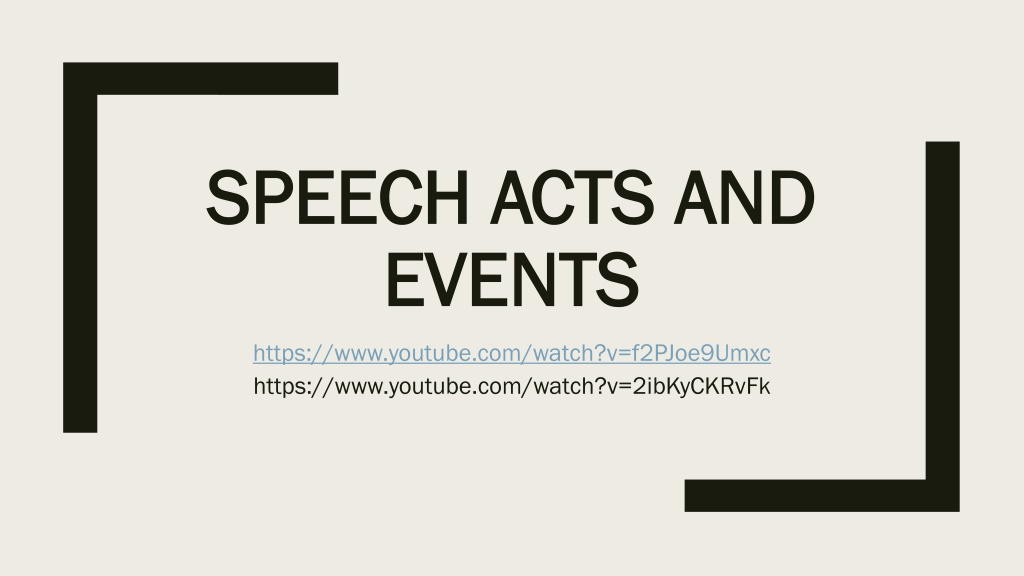
 undefined
undefined


![Prevention and Combating of Hate Crimes and Hate Speech Bill [B.9B.2018]](/thumb/60513/prevention-and-combating-of-hate-crimes-and-hate-speech-bill-b-9b-2018.jpg)

